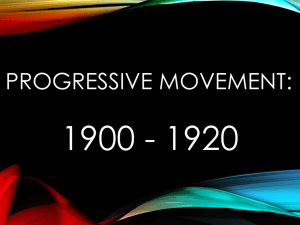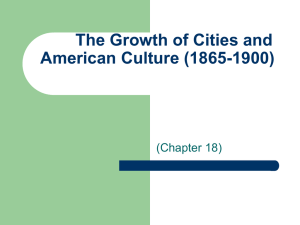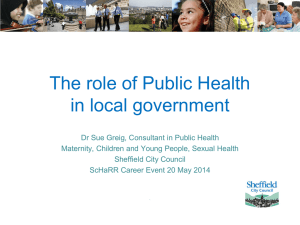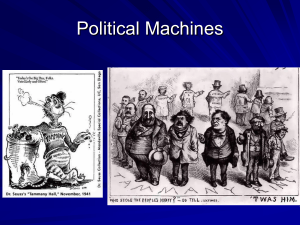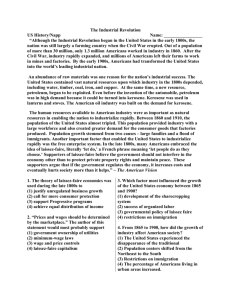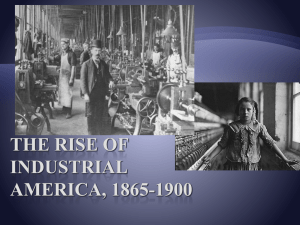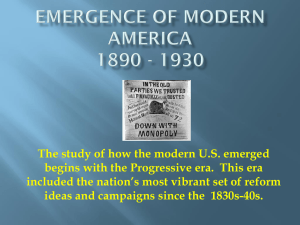Living Conditions of the Progressive Period
advertisement
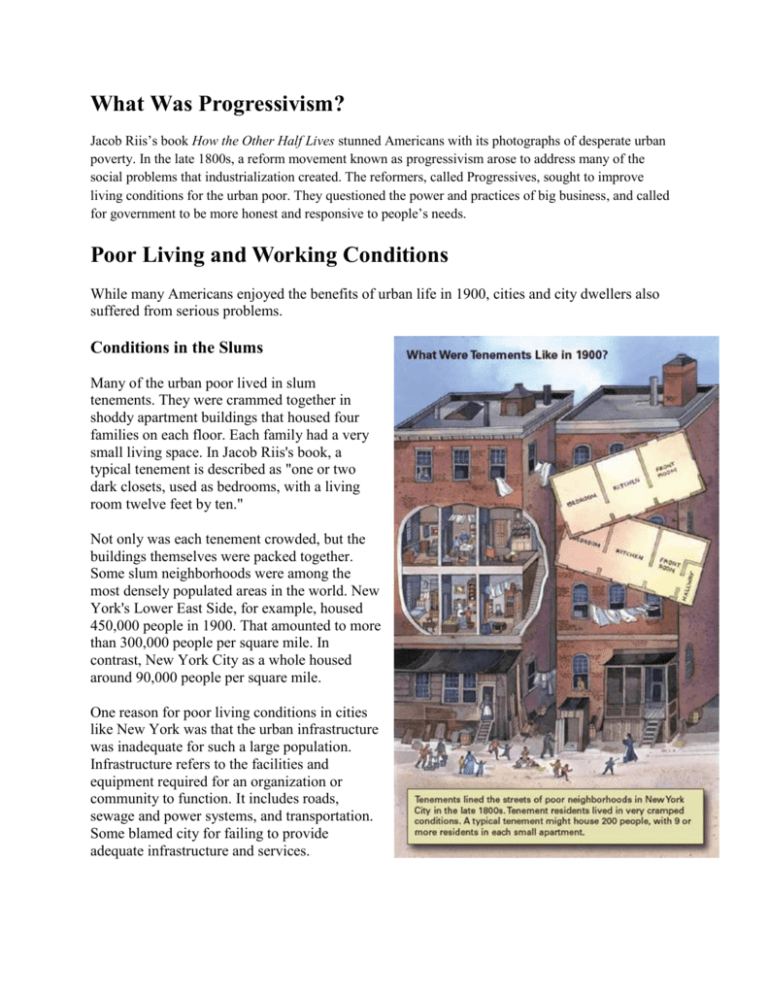
What Was Progressivism? Jacob Riis’s book How the Other Half Lives stunned Americans with its photographs of desperate urban poverty. In the late 1800s, a reform movement known as progressivism arose to address many of the social problems that industrialization created. The reformers, called Progressives, sought to improve living conditions for the urban poor. They questioned the power and practices of big business, and called for government to be more honest and responsive to people’s needs. Poor Living and Working Conditions While many Americans enjoyed the benefits of urban life in 1900, cities and city dwellers also suffered from serious problems. Conditions in the Slums Many of the urban poor lived in slum tenements. They were crammed together in shoddy apartment buildings that housed four families on each floor. Each family had a very small living space. In Jacob Riis's book, a typical tenement is described as "one or two dark closets, used as bedrooms, with a living room twelve feet by ten." Not only was each tenement crowded, but the buildings themselves were packed together. Some slum neighborhoods were among the most densely populated areas in the world. New York's Lower East Side, for example, housed 450,000 people in 1900. That amounted to more than 300,000 people per square mile. In contrast, New York City as a whole housed around 90,000 people per square mile. One reason for poor living conditions in cities like New York was that the urban infrastructure was inadequate for such a large population. Infrastructure refers to the facilities and equipment required for an organization or community to function. It includes roads, sewage and power systems, and transportation. Some blamed city for failing to provide adequate infrastructure and services. Lack of fire protection was one serious problem. At the turn of the century, many city roads and sidewalks were constructed of wood, making cities virtual firetraps. One historian described American cities of the day as "long lines of well-laid kindling." Much of Chicago burned to the ground in 1871, and much of San Francisco burned after the 1906 earthquake. Cities also suffered from sanitation problems. By 1900, many middle-class homes had running water and indoor plumbing. These amenities reduced the incidence of disease in some neighborhoods, but they increased the amount of wastewater that cities had to remove. City engineers developed sewer systems to do the job. In poorer neighborhoods that lacked indoor plumbing, however, the waste often ended up on the streets. As a result of poor sanitation, contagious diseases such as tuberculosis and pneumonia often spread quickly through crowded slums. Problems in the Workplace By 1900, unskilled factory work had replaced most skilled manufacturing jobs. Many factory workers found their work boring and strenuous. One worker said, "Life in a factory is perhaps, with the exception of prison life, the most monotonous life a human being can live." Factory work was also dangerous. Sharp blades threatened meatpackers. Cotton dust plagued textile workers. And fire posed a risk to nearly everyone who worked in close quarters in factories. Injuries could put workers out of jobs and throw their families into dire poverty. Other workers, especially in the garment industry, worked at home for companies that paid them for each piece of work they completed. Many employers squeezed their workers by reducing the rate they paid per piece. Workers then had to work harder and faster to earn the same amount. It was common among immigrants for entire families, including children, to do piecework so that the family could make enough money to survive. Unsafe Products: Buyer Beware Increased production meant that more products were available, but buying them was not always a good idea. Consumers often did not know what was in the products because the government did not regulate product quality. For example, many common medicines, like cough syrup, were unregulated. Some products made ridiculous claims for curing illnesses, with the "cures" often involving narcotics. Medicine labels boasted such ingredients as morphine, opium, and cocaine. These substances were not prohibited, but their risks were becoming more apparent. Popular magazines told stories of consumers who believed that these medicines would cure their illnesses, only to fall prey to drug addiction. Meanwhile, the growth of big businesses went largely unregulated, as monopolies [monopoly: the exclusive control over a good or service in a particular market, or a control that makes possible the manipulation of prices] took over many industries. Many Americans worried that small companies were being driven out of business and that monopolies were stifling opportunity. Reformers protested that big businesses were growing richer, while small businesses and the poor struggled even harder to survive. Problems with the Environment By the turn of the century, urbanization and industrialization were transforming not only American society but also the natural environment. By 1900, Americans had settled much of the country and exploited many of its natural resources. Doing so enabled tremendous economic growth, but it also came at a cost to the environment. Coal and other minerals were required to fuel industry. Factories burned coal to heat water to make the steam that powered machinery. The country was particularly rich in coal, but mining was dangerous and harmed the environment. Workers risked being buried alive if a mine caved in, and many got black-lung disease from breathing coal dust day after day. Mining scarred the land, leaving open shafts, slag heaps, and polluted streams behind. Unlike today, the government imposed no environmental regulations on mining companies. Oil drilling also took its toll on the land. The first commercial oil wells were drilled in Pennsylvania. By 1900, oil extraction was underway in Texas and California as well. But finding oil was difficult. Developers often drilled deep in search of black gold, only to come away empty-handed. Whether successful or not, they left the earth torn behind them. One historian explained that most Americans in the 1800s believed that "the river was waiting to be dammed . . . the prairie was waiting to be farmed, the woodlands to be cut down, and the desert to be irrigated." In other words, most people saw no problem with exploiting the environment and took no notice of the harm being done to the natural landscape. Polluting Water and Air Economic activities were also polluting the air and water in urban areas. In some cities, factories belched so much black smoke that it was difficult for people to breathe. In 1881, angry residents of New York City reported that the air smelled like sulfur, ammonia, kerosene, acid fumes, and phosphate fertilizer. Pittsburgh, a steelmaking city, was known for being particularly filthy. The air was so polluted that it soiled everything. The people who lived closest to the steel plants suffered the worst of the pollution, but it affected those living outside the industrial center as well. One historian has written, "People's hands and faces were constantly grimy, clean collars quickly acquired a thin layer of soot, and the . . . coal dust gave clothes hung out in the weekly wash a permanent yellow tinge." Another pollutant came from animals that lived in cities. Horses pulled carriages, and pigs roamed the streets eating garbage. Animal waste was often left where it landed, producing a foul stench and a serious disposal problem. According to one estimate, the 15,000 horses in Rochester, New York, left enough waste in a year to cover an acre of land with a layer 175 feet high. City water was also polluted. In some cities, household sewage and industrial pollutants were simply released into nearby water sources without regard for the consequences. Other cities did try to avoid contaminating their drinking water. In Chicago, for example, engineers reversed the flow of the Chicago River so that sewage and factory waste would not flow into Lake Michigan. Some cities developed reservoirs to keep drinking water separate from wastewater. In some cases, rivers that were in the way or became too much of a health hazard were simply paved over. The Politics of Fraud and Bribery Another problem at the turn of the century was political corruption. In 1902, journalist Lincoln Steffens published The Shame of the Cities, a book on corruption in city government. The book exposed the rampant fraud that plagued cities throughout the nation. Steffens reported that politicians spoke openly about accepting bribes. "I make no pretensions to virtue," one politician said, "not even on Sunday." Corruption served the interests of dishonest politicians and those who bribed them, while weakening the political influence of average Americans. In short, it distorted and undermined democracy. Political Machines and Bosses By 1900, many cities were controlled by political machines [an organization consisting of fulltime politicians whose main goal was to retain political power and the money and influence that went with it]. These organizations consisted of full-time politicians whose main goal was to get and keep political power and the money and influence that went with it. Machines were usually associated with a political party. Party politicians joined forces to limit competition, while increasing their own power and wealth. At the top of this corrupt structure was the political boss, who controlled the machine and its politicians. Perhaps the most infamous of these bosses was William "Boss" Tweed of New York's Tammany Hall [a political machine in New York City] machine, who in the early 1870s cheated the city out of as much as $200 million. Political machines exercised control at all levels of city government, down to the wards and precincts that subdivided most cities. Ward bosses and precinct captains got to know local residents and offered them assistance in exchange for political support. They helped immigrants who were sick or out of work. As one New York City ward boss said, "I never ask a hungry man about his past; I feed him, not because he is good, but because he needs food." This aid could take a wide variety of forms, including supplying a Christmas turkey or helping a grieving family by paying for a funeral. In exchange, residents agreed to vote for machine politicians at election time. In some ways, the political machines worked for the good of city dwellers, particularly immigrants. At a time when the national and state governments did not provide such benefits as welfare for unemployed workers, local political machines filled the void. Corruption in Local and State Politics Although political machines provided aid, they also stifled opportunity for many citizens. Political bosses controlled access to city jobs, such as employment in the police and fire departments or on construction projects. With a good word from a boss, a poorly qualified person could land a job in place of a capable applicant. The political machine also controlled business opportunities. To get a city work contract, a company often had to donate to the machine's reelection campaign. Many businesses also paid politicians to keep the city government from interfering with their activities. Such payoffs became part of the cost of doing business. Muckrakers called them bribery. The political machines profited from urban entertainment, both legal and illegal. In exchange for a payoff, the boss could clear the way for such illegal activities as gambling. Even legal businesses such as baseball teams and vaudeville theaters paid the machine. Some political bosses saw these payments as informal taxes. They used some of the revenue to help those in need, but they made sure they profited themselves. To keep control, political machines rigged local elections. Average citizens had little influence in choosing candidates, and the machine frequently used fraud to win at the polls. Candidates might pay citizens for their votes or stuff the ballot box with phony votes. By controlling elections, political machines maintained their grip on American cities. At the state level, corrupt politicians tied to powerful industries, such as railroads and mining, controlled many state governments. In passing legislation that favored big business, state legislatures and governors often ignored the needs of average citizens. Corruption on the National Level The national government also suffered from corruption. For example, the Constitution gave state legislatures the power to choose senators, but corporations often bribed state legislators to elect their favored candidates to the Senate. The Senate became known as the Millionaires Club because many of its members were wealthy men with close ties to powerful industries. In the late 1800s, the Senate became known as the Millionaires Club because so many senators got rich on contributions from big business. This 1890 cartoon, titled “The Bosses of the Senate,” shows tiny senators completely overshadowed by bloated trusts and monopolies. The sign at the back of the chamber reads, “This is a Senate of the Monopolists by the Monopolists and for the Monopolists!” In both the House and the Senate, politicians received campaign contributions from big business in exchange for passing favorable legislation. The railroad monopolies, for example, frequently gave company stock to members of Congress who passed laws that strengthened the railroads. Other businesses also gave money to lawmakers who worked to limit competition. Politicians frequently engaged in patronage [the practice of politicians giving jobs to friends and supporters]—giving jobs to friends and supporters. Some of these jobs went to unqualified people. Social Tensions American cities in 1900 brought together many types of people in crowded and often difficult circumstances. As a result, social tensions increased. Many poor city dwellers resented the comfortable lives of the rich, while the rich often looked down on the poor as the source of urban problems. Many African Americans faced racism and violence as they struggled to improve their lives and claim their democratic rights. Women were also demanding greater opportunities and rights. Meanwhile, many American families feared that the stresses and strains of urban life were eroding traditional values. Growing Differences between Social Classes During the late 1800s, the gap between rich and poor grew wider. Between 1865 and 1900, a small percentage of Americans grew fabulously wealthy. By 1891, according to one estimate, there were 120 Americans who were worth at least $10 million, an enormous sum at the time. At the same time, the arrival of many immigrants swelled the ranks of the working class. Many workers found it nearly impossible to get ahead. Although wages increased gradually, the cost of living rose faster. So while the rich got richer, the poor continued to live in harsh circumstances. Many took lodgers into their tiny flats to help share the cost of rent. Between the two extremes, the middle class expanded as a result of the rising productivity of the American economy. The growing middle class included doctors, lawyers, ministers, small business owners, merchants, and mid-level company managers. By 1900, American cities were organized in ways that reflected class, race, and ethnic differences. The rich lived in mansions on streets like New York's elegant Fifth Avenue. Many Fifth Avenue residents also owned summer homes in places like Newport, Rhode Island. Their summer "cottages" were actually mansions resembling European palaces. During this period, many middle-class families moved to comfortable homes in newly built suburbs. The men often commuted on streetcars, part of new urban transit systems. Members of the middle class tried to make their homes appear as elegant as the homes of the wealthy. Their houses often featured stained glass windows and fine furniture. Many also had reproductions of famous paintings hanging on their walls. Working-class people remained in the cities. Immigrants tended to cluster together in ethnic neighborhoods, where they could maintain many of their old customs. Some immigrants, however, stayed in these areas because they were not allowed to live anywhere else. The Chinese in San Francisco were jammed together in one district known as Chinatown because they were barred from other areas. In cities like San Antonio and Los Angeles, Mexican immigrants lived in neighborhoods called barrios. African American migrants, too, generally lived in neighborhoods separated from other city residents. Life for African Americans In the 35 years since the end of the Civil War and the abolition of slavery, African Americans had made few gains in their struggle for equality. Many southern states had passed Jim Crow laws that segregated blacks from whites in trains, schools, hospitals, and other public places. Signs saying "White Only" and "Colored Only" told black Americans which waiting rooms they could enter, which bathrooms they could use, and where they could sit in theaters. Segregation affected nearly every aspect of public life in the South at the beginning of the 20th century. Jim Crow laws in the South segregated African Americans. This photograph shows a segregated drinking fountain. Such laws made it almost impossible for southern blacks to advance by isolating them and denying them opportunities to participate fully in American life. In addition, by 1900 most African Americans in the South had been disenfranchised. Although the Fifteenth Amendment declared that voting rights could not be denied on the basis of "race, color, or previous condition of servitude," southern states found ways to bypass the law. Some state laws required potential voters to prove that they could read and write. These literacy tests often kept African American men from voting. So did poll taxes and property requirements. "Grandfather clauses" were another way to deny African American men the vote. Such clauses limited voting only to those men whose fathers or grandfathers had had the right to vote in 1867. In addition, as the 20th century began, most American women did not have the right to vote. Although a few western states had granted voting rights to women, there was still no women's suffrage at the national level. Women known as suffragists actively pursued voting rights. Violence against blacks was also common. Between 1882 and 1900, about 70 lynchings took place every year, mostly in the South. Between 1894 and 1898, about 550 African Americans were lynched. The victims were typically hanged or burned to death. In some cities, in both the North and the South, large-scale mob violence broke out against African Americans. Challenges for the American Family The American family also faced challenges at the turn of the century, most notably around the issue of child labor. By 1900, roughly one out of every five children between the ages of 10 and 15 was a wage worker. About 1.7 million children toiled in factories, sweatshops, and mines or worked in other nonfarm jobs such as shining shoes and selling newspapers. "Breaker boys" in coal mines often worked 14 to 16 hours a day separating slate rock from coal. Grueling workweeks could stretch to 72 hours, leaving child workers little time for anything else. Lewis Hine, who documented conditions of child labor in the early 20th century, took this photograph of children picking cotton. Lack of education was another problem. Although public education expanded in the late 1800s, working for wages kept many children out of school. By and large, African Americans had even fewer educational opportunities than whites. In the segregated South, schools for blacks were often of inferior quality. Some African Americans, however, gained useful vocational training at all-black colleges such as Alabama's Tuskegee Institute. The treatment of children by the criminal justice system was also a problem. In many places, the law required juvenile offenders to be sentenced to reform school, but accused children did not always get a trial. Even if the children were not convicted, they might be sent away for rehabilitation. In addition, children living on the streets were often treated as juvenile offenders. Addressing the Problems Reform-minded writers were the first to expose many of the social ills that Progressives targeted. Popular magazines printed journalists’ firsthand accounts of injustices and horrors they had witnessed. These journalists were known as muckrakers because they “raked up” or exposed the filth of society. Most of the muckrakers’ articles focused on business and political corruption. Ida Tarbell wrote a scathing report condemning the business practices of the Standard Oil Company in McClure’s Magazine. Tarbell revealed how John D. Rockefeller crushed his competition in his quest to gain control over the oil business. Other muckrakers wrote about insurance and stock manipulation, the exploitation of child labor, slum conditions, and racial discrimination. Lincoln Steffens exposed the corruption of city governments in The Shame of the Cities (1904). Frank Norris described the strangling power of a monopolistic railroad in his 1901 novel The Octopus: A Story of California. The muckrakers helped prepare the way for many reforms in the United States.
